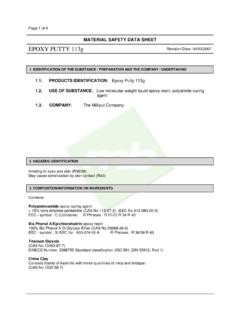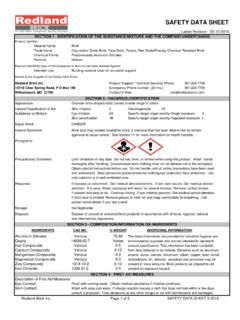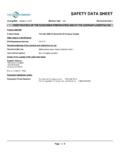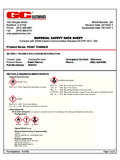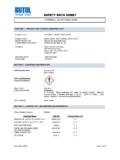Transcription of XenoEnergy Lithium Battery
1 XenoEnergy CO., LTD. Revision: 2018-01A safety data sheet 1. Product Identification 1) Product Name Lithium Thionyl Chloride Battery (Li-SOCl2, Non-Rechargeable, ) Single Cells or Multi Packs of following models Small Size Battery XL-050F, XLP-050F, XL-050H Medium Size Battery XL-055F, XLP-055F, XL-060F, XLP-060F, XL-060H, XL-100F Big Size Battery XL-140F, XL-145F, XL-200F, XL-205F, XL-1459F, XL-2059F 2) Manufacturer: XenoEnergy Co., Ltd. 70-7, Mooha-ro, Hwaseong-shi, Kyeonggi-do, Korea, 18279 3) Emergency Contact International: +82-70-8277-6310 70-7, Mooha-ro, Namyang-eup, Hwaseong-shi, Kyeonggi-do, Korea, 18279 USA or Canada: +1 (860) 945-1177 680, Main Street, Suite #206, Watertown, CT 06795, USA 2.
2 Hazard Identification The Lithium Thionyl Chloride Batteries have hermetically sealed structure, so they are not hazardous when they are used in the recommendations of the manufacturer. Do not short circuit, recharge, puncture, incinerate, crush, immerse, force discharge or expose to temperatures above the declared operating temperature range of the product. Risk of fire or explosion. Under normal usage conditions, the electrode materials and liquid electrolyte cannot be leaked to the outside. Risk of exposure only in case of abuse (mechanical, thermal, electrical) which leads to the rupture of the Battery container. XenoEnergy Lithium Battery XenoEnergy CO., LTD. Electrolyte is toxic and corrosive and causes irritation, skin burn, lung injuries, asthma and other respiratory disorders 3.
3 Composition and Information on Ingredients Substance CAS No. Approximate percent of total weight (%) Hazard Symbol R-phrases Lithium Metal 7439-93-2 3-5 F, C 14/15-34 Thionyl Chloride 7719-09-7 33-45 C 14-34-37 Aluminum Chloride 7446-70-0 2-5 Lithium Chloride 7447-41-8 1-2 Carbon 1333-86-4 3-5 Hazard Symbols: C Corrosive / F Highly flammable R-Phrases: R 14 Reacts violently with water R 14/15 Reacts violently with water liberating extremely flammable gases R 34 Causes burns R 37 Irritating to respiratory system 4. First Aid Measures Eye Contact - Immediately flush eye with plenty of water for at least 15 minutes. Seek medical attention. Skin Contact - Immediately flush skin with plenty of running water for at least 15 minutes.
4 Seek medical attention. Inhalation - Immediately remove to fresh air. If necessary, administer oxygen and seek medical attention. Ingestion - Immediately wash mouth with plenty of water and drink plenty of water. Seek medical attention 5. Fire Fighting Measures Lith-X (Class D extinguishing media) and Dried Sand are effective extinguishing media on fires involving a few Lithium batteries. If cells are already catching a fire, do not use Water, CO2, Halon and Dry Powder or Soda Ash Extinguishers. If the fire is in adjacent area and the fire is not progressed, CO2 Extinguishers or copious amounts of cold water can be effective extinguishing media to cool down burning Li-SOCl2 cells and batteries. XenoEnergy CO., LTD.
5 6. Accidental Release Measures Under abusive conditions, the Battery contained materials may leak. Put the leaked batteries into small container or plastic bag adding the neutralizing agents of Sodium carbonate (Na2CO3), chalk (CaCO3) or lime (CaO) powder. 7. Handling and Storage Handling Do not crush, puncture or short circuit. Do not directly heat or solder, over charge the Battery or forced discharge. Do not throw into fire. Storage - Store in a cool (below 30 C) and ventilated area with less temperature and moisture effect. Do not place near heating equipment or direct sunlight for a long time. Keep the batteries in original Battery package. Others - Lithium Thionyl Chloride batteries are not rechargeable batteries and should not be charged.
6 Avoid the deformation of batteries by pressure. Keep the recommended usage conditions and temperatures by the manufacturer. 8. Exposure Controls and Personal Protection Respiratory Protection - As any fire situation is happened, use self-contained breathing apparatus. Eye Protection - safety glasses are recommended. Protective Gloves - In case of leakage, wear gloves. Other Protective Clothing: In the event of leakage, wear chemical apron. 9. Physical and Chemical Properties Melting Point N/A Boiling Point N/A Vapor Pressure N/A Specific Gravity N/A Vapor Density N/A Physical State Solid Solubility in Water N/A PH N/A Appearance Geometric Solid Object Odor If leaked, giving off pungent corrosive odor XenoEnergy CO., LTD.
7 10. Stability and Reactivity Stability - Stable (hermetically sealed type, used in recommended conditions) Condition to Avoid - Give too much force, drop, crush & disassemble, short-circuit, recharge, fire & heat above 100 C (212 F), incinerate and etc. Material to Avoid - Alkali, water, mineral acid Hazardous Decomposition Products - * Reaction of Lithium metal with water: Hydrogen (H2) / Lithium oxide (Li2O) and Lithium hydroxide (LiOH) * Thermal decomposition over 150 C: Hydrochloric acid (HCI) and Sulfur dioxide (SO2) * Electrolyte ( Lithium tetrachloroaluminate, LiAlCl4) with water: Hydrochloric acid (HCI) fumes, Lithium oxide (Li2O), Lithium hydroxide (LiOH) and Aluminum hydroxide (Al(OH)3) 11. Toxicological Information Not Applicable In the event of rupture or leakage, corrosive fumes from the Battery can cause Inhalation - Burn or irritation of the respiratory system Eye Contact - Redness, tearing, burns Skin - Skin irritation and burns Ingestion - Tissue damage to throat and gastro-respiratory track Medical conditions generally aggravated by exposure - eczema, skin allergies, lung injuries, asthma and other respiratory disorders may occur.
8 12. Ecological Information 1) Lithium Thionyl Chloride batteries do not have environmental hazard under normal usage and proper disposal. 2) Lithium Thionyl Chloride batteries do not contain mercury, cadmium or other heavy metals. 13. Disposal 1) Dispose under the regulation in each country. 2) Dispose by incineration or burial at permitted waste treatment and disposal sites XenoEnergy CO., LTD. 14. Transportation 1) Product Category: Lithium Metal Batteries (with All UN Test Approval) 2) UN ID No. UN3090 or UN3091 UN 3090: Lithium METAL BATTERIES UN 3091: Lithium METAL BATTERIES CONTAINED IN EQUIPMENT, or Lithium METAL BATTERIES PACKED WITH EQUIPMENT - Lithium metal cells and batteries are considered as Dangerous Goods with UN3090 and UN3091.
9 - Depending on their Lithium metal contents, some cells or batteries may be regarded as non-dangerous goods without Class 9 nomination. 3) Regulation A. Air Transportation: IATA 59th Edition 2018, Dangerous Goods Regulations - All cells and batteries must be tested in accordance with the UN Manual of Tests and Criteria Part III Subsection (DGR ). Small Size Battery : Lithium Contents Cells 1g / Batteries 2g Packing Instruction 968 Section II - No Passenger Cargo, Cargo Aircraft Only, No Overpack and Pallet Packing - Package cells 1g = Net // cells > 1g = 8cells // batteries > 2g = 2cells - Label: Lithium Battery Mark (or existing Lithium Battery Handling Label until Dec. 2018), Cargo Aircraft Only label - Not more than one package prepared in accordance with this section may be placed into an over pack - Pallet packing do not allow, only pack - Use IB if Package exceeds Section II limits and more than 1 package Medium Size Battery : Lithium Contents Cells >1g / Batteries 2g Packing Instruction 968 Section IB - No Passenger Cargo, Cargo Aircraft Only - Package Net - Label: Lithium Battery Mark (or existing Lithium Battery Handling Label until Dec.
10 2018), Lithium Battery Class 9 label (or existing Class 9 label until Dec. 2018), Cargo Aircraft Only label - DG Declaration Big Size Battery : Lithium Contents Cells 1g / Batteries >2g Package instruction 968 Section IA - No Passenger Cargo, Cargo Aircraft Only - Package 35kg - Label Lithium Battery Class 9 Label (or existing Class 9 label until Dec. 2018), Cargo Aircraft Only label - DG Declaration & Certification XenoEnergy CO., LTD. B. Sea Transportation: IMDG Code 2015 Small & Medium Size Battery : Lithium Contents Cells 1g Special Provision 188 (Exception) - Lithium Metal cells <1g, batteries <2g Not subject to Class 9 (Non-DG) - Packing Group I - Each cell or Battery is of the type proved to meet the requirements of each test of the Manual Tests and Criteria Part III, sub section and batteries manufactured.
